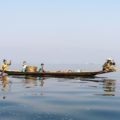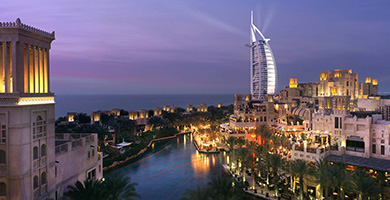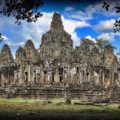Raising the Dead in Burma, Part II
As the ATR-72 took off from Yangon, we left behind the remnants of our family’s past, but the one-hour flight north would lead us to discover what had become of Burma’s past.
In the year 1044, the young teenager Aniruddha killed his royal cousin in single combat and seized the throne of the small kingdom of Pagan (now Bagan). From his throne on the banks of the Irrawaddy River, King Aniruddha launched an ambitious campaign, running troops, elephants, and horses in every direction. He created an empire closely resembling Burma’s present-day borders and managed to unify it under Theravada Buddhism. Aniruddha built places of worship by the thousands and made Pagan a bustling mecca for Buddhist study. At one time an estimated 13,000 temples and stupas in Pagan teemed with life and learning. In the 13th century, Marco Polo described the town as a “gilded city alive with tinkling bells and the swishing sounds of monks’ robes.”
Today, the ruins of some 2000-plus stupas stand clustered in the 16-square-mile area now known as Old Bagan. And watching sunset hues blanket themselves over these picturesque relics is nothing short of spectacular. As the sun started to sink from the sky, my cousin Stuart, my son Ian, and I shed our shoes and began to climb one of the ruins. With cameras dangling from our sides, we ascended hundreds of stairs at an obscenely steep angle. Seeing the skies turn pink and orange behind the shapely silhouettes of these ancient places of worship, it occurred to me that, although my own belief system may differ from Buddhism, I had found sanctuary atop this stupa.
We found another haven that evening at the Bagan Thiripyitsaya Sanctuary Resort. On the banks of the Irrawaddy River, twenty-four acres of landscaped gardens surround 76 guest bungalows ranging from superior to lavish. Originally built by the government as a guesthouse for visiting dignitaries, the resort is now privately managed and offers myriad activities including horseback riding, biking, golf, and blissful treatments at their indoor and outdoor spa facilities. If those forms of recreation aren’t enough to relax the mind, the staff can arrange for a Buddhist monk to guide you through a personal mediation session while overlooking the Irrawaddy River.
Although the Thiripyitsaya Resort provides excellent food for the soul, one can’t ignore their culinary capabilities. On a veranda under the stars, the sounds of a Burmese xylophone (or patala) resonated as the restaurant’s waitstaff placed elegant lacquerware dishes full of superb Burmese delicacies in front of each of us. The dishes themselves are an art form—one for which Bagan has been famous for centuries.
Observing the lacquerware process itself gives one a new appreciation for each handmade dish. The family-owned Bagan House Artistic Lacquerware Workshop takes travelers through the steps of pan yun (the art of lacquerware). Artisans place layer upon layer of sap from the Thitsee tree on a bamboo strip base. A single dish can take months to finish. Each design is engraved freehand in microscopic detail. So it’s worth finding a piece that appeals to you and shipping it back home. Fourth-generation owner Ma Maw and her family welcomed us with smiles and humorous conversation while we made our choices. I chose a red platter, elevated on many intricately-designed legs—a perfect showpiece for serving Asian cuisine in my home.
As the road to Mandalay (immortalized by Rudyard Kipling’s poetry) can take eight hours by car and we had only one day left to travel in Burma, we boarded a Yangon Airways plane and flew to Mandalay International Airport. We chose to venture beyond the many attractions in the city of Mandalay and took a scenic two-hour drive east to the town of Pyin Oo Lwin (also known as Maymyo).
Famous for its mild weather and British colonial mansions, Pyin Oo Lwin was originally a 19th century military outpost. After the folks of the British military and governmental machine discovered this climatically-advantageous hill town, they removed themselves from hot and humid Rangoon and settled in Pyin Oo Lwin during the summer months. The town, renamed Maymyo after British military commander Colonel May, was awash with horses and carriages as people went about their social and bureaucratic duties. Business magnates attempted to outdo their neighbors by building elaborate summer mansions.
After the exodus of the British Raj, Maymyo became the home for the Defense Academy of the Burmese military and a center for the farming and trade of coffee, strawberries, and flowers. A number of the venerable old mansions and cottages have been restored and converted to guesthouses and restaurants. One such summer cottage is now the home of the Club Terrace Food Lounge restaurant. Sitting under umbrellas overlooking the extensive gardens, guests can enjoy a full menu of Burmese cuisine including a delectable butterfish curry and fried garden vegetables—a Maymyo specialty.
Although we did not stay in Maymyo overnight, we checked out the Candacraig Hotel, the oldest hotel in Myanmar. The Candacraig House was built in 1904 by British Bombay Burma Timber Company to house their expatriate executives during their stay in Burma. On the seven-acre grounds stands a vine-covered, Edwardian-style mansion with guestrooms and a beautifully-crafted teakwood grand staircase. The Candacraig Hotel’s restaurant serves divine European, Chinese, and Burmese dishes.
If you want light fare, The Golden Triangle Café and Bakery, located on Pyin Oo Lwin’s main thoroughfare (Mandalay-Lashio Road), serves appetizing European-style pastries and ice cream. In addition to enjoying a cup of coffee or tea, you can purchase packages of locally grown, roasted coffee beans and tea leaves to take back home.
Next we explored Mandalay briefly, taking a rather rushed drive through the city on the way to the airport. Once the capital of pre-British Burma, Mandalay is now the economic hub of Myanmar. The city, with its modern shops, condominiums, and large Chinese presence, has an unmistakable commerce-driven energy. However, there are a number of historically significant sites in the Mandalay area.
The U Bein Bridge stretches across the Taungthaman Lake to the old capital city of Amarapura. At 1.2 kilometers, it is the longest teak footbridge in the world and the most photographed sight in Myanmar. A walk up Mandalay Hill offers a view of the sprawling metropolis and the Mandalay Fort. King Mindon, the last king of Burma and founder of Mandalay, built the fortress with its large moat and four walls, each stretching out over two kilometers. Behind the fort walls sits Mindon’s Royal Palace, rebuilt after being destroyed in a World War II battle between the British and Japanese. King Mindon also built the Kuthodaw Pagoda, known as the “world’s largest book.” The pagoda’s multiple shrines contain marble slabs engraved with all of the portions of the Tripitaka, Theravada Buddhism’s sacred text.
As the plane ascended into the sky away from the place that had been home to our family for generations, the sacred sites, graves, and ruins far below, it occurred to me that while the trip had started as a search for family graves in a Yangon Cemetery, we found a country that was very much alive. The Burma of a bygone era had changed, but Myanmar today inspired us. The warmth of its people in the face of adversity and the colorful beauty of its ancient relics made us want to return and experience more of Myanmar.
Bagan Thiripyitsaya Sanctuary Resort: Rooms range from US$85 – $320. Address: Bagan Archeological Zone, Old Bagan, Mandalay Division, Union of Myanmar. Tel: +95-61-60048 / 60049; Fax: +95-61-60033; E-mail: rsvn@thiripyitsaya-resort.com
Bagan House Artistic Lacquerware Workshop: Address: No. 9 Jasmin Road, New Bagan, Myanmar. Tel/Fax +95 61-60767
The Club Terrace Food Lounge: Address: No. 25, Club Road, Quarter No. 5, Pyin Oo Lwin. Tel: +95-85-22612
Candacraig Hotel: Rooms range from US$50 – $100. Address: 6th Quarter Anawrahtha Street, Pyin Oo Lwin. Tel: +95-85-22047.
Golden Triangle Café: Address: Mandalay-Lashio Road, Pyin Oo Lwin, Myanmar. Tel: 95-85-21288.
Tour information: Myanmar Shalom Travels & Tours uses guides local to each region and has more than fifteen tour packages including specialized itineraries such as a culinary tour and a “Kipling’s Burma” tour. They also arrange for cruises on the Irrawaddy River and can customize tours for individuals. Tel: 646-734-8472 (US) or +95-1-252814 (Intl.). Email: info@myanmarshalom.com.
Photos courtesy of Lynne Friedman and Sammy Samuels.
Latest posts by Lynne Friedman
- Raising the Dead in Burma, Part II - November 24, 2009
- Raising the Dead in Burma – Part I - November 10, 2009










